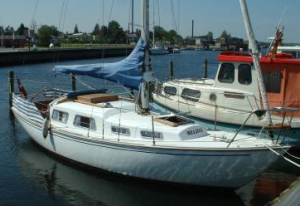
The Great Dane 28 was inspired both by the Folkboat and the Sisu Spidsgatter. She looks rather similar to the Twister (in the UK), but both her hull and complete coachroof/deck mouldings have always been made of GRP.
The cockpit coamings, wash-boards, hatches and locker-tops are of teak and her transom-hung rudder extends the full depth from transom to keel. The propeller is sited in a cut-out of the rudder, giving it maximum protection from fouling. The long keel of encapsulated lead gives her a low centre of gravity and a 46% ballast ratio. The cut-away forefoot reduces some of the maneuverability difficulties traditionally associated with long-keeled boats in tight spaces. The off-centre heavy teak main hatch slides on brass rails and the companionway is of a comfortable width and depth. Moving from cockpit to saloon is safe and made easy by the steps covering the forward end of the engine. The engine is also accessed by removing the cockpit sole.

Below decks, there is just over 6 ft headroom in the saloon (1.8 m). The layout varies, but a dinette to port was the standard in the boat built before 1970. This converts to a small double berth and there is a galley and quarter berth to starboard, with foot space below the starboard cockpit seat. The generous use of teak below decks gives a warm, traditional appearance. The heads (to port) and hanging locker (to starboard) separate the saloon from the forward cabin with its V-berth, which has large lockers beneath it. The forepeak contains the anchor chain.
In the more recently built boats, the dinette at port side has been changed into a longitudinal table and a L-shape sofa that can also be transformed into a double berth. With another sofa at starboard, the galley is in the rear of that saloon. The cockpit coamings are made of fibreglass and the forehatch made of aluminium and acrylated hatch.









